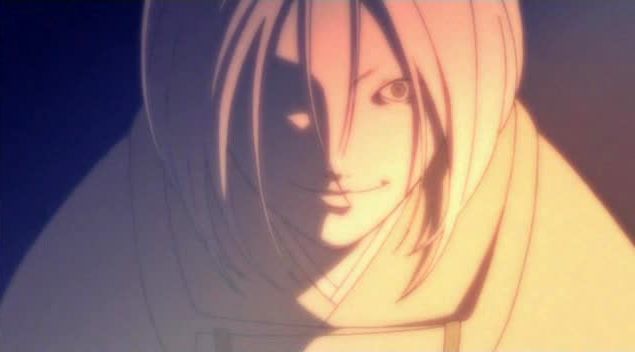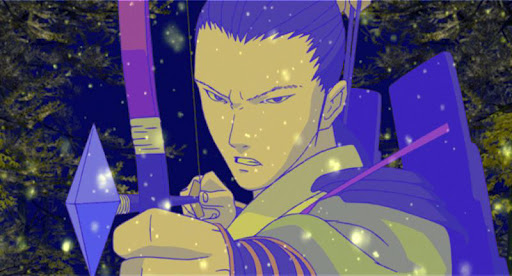 |
| From https://m.media-amazon.com/images/M/MV5BNjIzMTBlNTktNTNhOC00NDk0LTk0 Y2EtY2Q4NjQ5ODVhZDE1XkEyXkFqcGdeQXVyMzM4MjM0Nzg@._V1_.jpg |
Director: Kanji Wakabayashi
Screenplay: Nobuhisa Terado
Voice Cast: Mitsuki Saiga as
Kintoki Sakatano, Showtaro Morikubo as Raikou Minamotono, Yurika Hino as
Princess Ouni/Shuten Dohji, Ai Orikasa as Douji Ibaragi, Fumiko Osaka as Fuji, Hikaru
Hanada as Sadamitsu Usuino, Ikue Kimura as Yamabuki
Viewed in Japanese with English Subtitles
Synopsis: In the Heian period, a girl named Kintoki is rescued by Raikou
from being killed by her uncle, who intended to take over from her family. Years
later, treated as a boy as her family intended to, she is trained as a member
of Raikou's band of warriors; unfortunately a figure from her past named Princess
Ouni, who fell in love with her presuming her to be a boy, has come forth with
vengeance in mind against all those on Raikou's side, with black magic and
villains to assist her.
Kai Doh Maru was an OVA anime I once watched and had a really
scathing view of; I had no idea why revisiting this years later, compelled by
the work upon this revisit years later, until by the ending where the one major
flaw with Kai Doh Maru appears. If anything, what likely annoyed me back long
ago was that contrary to what the old Manga Entertainment UK DVD says,
suggesting it is eight minutes long, Kai
Doh Maru is only under fifty minutes, a usual OVA length from a decade earlier
in the nineties but not obviously over feature length. Manga Entertainment's old style of anime distribution, for all my
nostalgia, is also with awareness of how I despise the many things they did
like "dubtitles", and how they were capable of this type of hucksterism,
presuming the additional minutes are the extras, even into the 2000s, even into
the 2010s when they're now respectable distributors of Pokemon films when I return to their old catalogue second hand.
Kai Doh Maru is nonetheless fascinating - long before (over) expensive
Blu Ray releases for the USA, Aniplex
was helping to produce what is as much a technical demonstration of new
artistic flourishes as well as a very interesting and entertainment anime. Some
might find it slow and dialogue heavy for an action samurai story, but for me
the slow burn tone of introspection punctured by action was better in itself. Immediately
intriguing, after showing Kintoki's rescue at a young age in the beginning, is
that this follows a female character in the lead, raised as a boy and taught to
be a soldier in a group including a former Buddhist monk who still wears the
sacred garb and a cocky womaniser, treated as an equal if a younger member and
once being called their princess who has teeth. Her gender is not used as a
cheap emotional ploy. When it is of importance it's for more fascinating
reasons - her clear unbridled love for Raikou, and the issue that the lead villainess
is romantically in love with her but, rather than a homophobic slant, that its tragically
a romance without her knowing Kintoki is a girl, desiring to possess the
heroine as flashbacks show a naive childish love poisoned by her own clan being
massacred and driving her to revenge.
 |
| From https://alchetron.com/cdn/kai-doh-maru-8cdcfaee- 3378-4406-aae6-e9ce5f6c7a1-resize-750.jpg |
Action wise, when there is action, its solid and with a touch of the gorier samurai stories, where losing a hand doesn't incapacitate anyone just slows them down. The supernatural bent, veering near ninjas and other groups as supernatural beings as with the likes of Ninja Scroll (1993), is fascinating as the plot ramps this side further and further as it goes along. Kidnapping and brain washing children, using their bodies to house malicious spirits, is the start but it then turns into an entire town's population through masks becoming mindless, fire starting minions who move as if like zombies. All it is compelling, helped that, noticeably, there's a sense of the production tapping into their country's own spirituality and folklore, especially as Kintoki is a female interpretation of the folk heroine figure Kintarō. Even if, for a foreigner like me with little knowledge, this story made up details for artistic effect, there's still the better sense that the production was not pulling fantasy clichés out of their arses but using more carefully influenced supernatural and folklore material.
This drawing of culture is to be
found also in the most divisive aspect of Kai
Doh Maru, its art style. Washed out and light in tone, enhanced with CGI,
the style is still unique for me immensely, still with a great idiosyncrasy
especially in its combination with realistic character designs. It's revealed
to be openly inspired by Japanese classical art, as the ending credits include tableaus,
still paintings, of where the characters end up in a form of epilogue, with
poetry drawn on and spoken at the same time.
 |
| From https://www.animeclick.it/images/ Anime_big/KaiDohMaru/KaiDohMaru7.jpg |
The issue with Kai Doh Maru? An abrupt ending. [Spoiler Warning] now - it leads to Raikou facing one of his own, possessed by the evil group as a puppet, and Kintoki with the Princess. Even if Manga Entertainment didn't dupe me for a second time, thinking this was feature length, the conclusion is still brisk. Ironically, it didn't have to be over ten or twenty minutes longer, or feature length, just even five minutes in this case enough to have fleshed everything out. Five more minutes, in a rare case here, would've been enough for the emotional impact to fully succeed. One moment, Kintoki staggering out stabbed in the gut as she finds Raikou dead, is enough to suggest all that has taken place, but a minute longer in dramatic height for both sides, a snippet of a fight with Raikou even if its deliberately left ambiguous what happened, more weight on the Princess discovering Kintoki was a girl and the built to what happened to them inside, would've been enough. Literally, for this OVA another draft of this ending, just to clarify without even dialogue but just images, would've been enough for me to say Kai Doh Maru is a very underrated and neglected OVA from when straight-to-video anime was sadly passing out in popularity. [Spoiler Ends]
Now it's a case of a very
underrated and neglected OVA from when straight-to-video anime was sadly
passing out in popularity with one little caveat in terms of a vague shrug of
an ending.
 |
| From https://silentdivergence.files.wordpress.com/2012/05/121608-11.jpg |
No comments:
Post a Comment